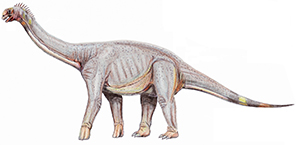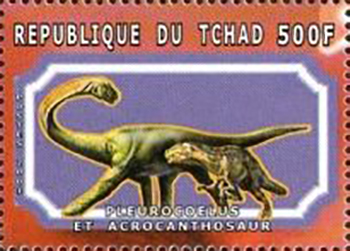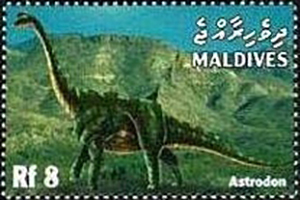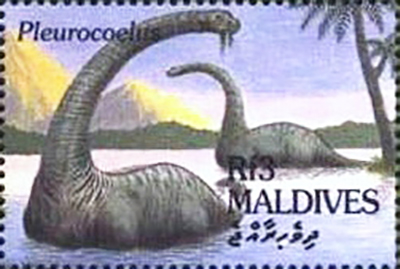Astrodon johnstoni Leidy, 1859

(Da: fr.wikipedia.org)
Phylum: Chordata Haeckel, 1874
Subphylum: Vertebrata Cuvier, 1812
Classe: Dinosauria Owen, 1841
Ordine: Saurischia Seeley, 1887
Famiglia: Brachiosauridae Riggs, 1904
Genere: Astrodon Johnston, 1859
Descrizione
Questo dinosauro è conosciuto grazie a esemplari incompleti, comprendenti vertebre, denti e ossa delle zampe. Un esemplare adulto doveva raggiungere i 15/18 metri di lunghezza e i 9 di altezza. Come tutti i sauropodi, Astrodon possedeva collo e coda allungati, mentre gli arti erano massicci e colonnari. È probabile che il corpo voluminoso avesse un profilo elevato, come quello di altri sauropodi macronari. La storia della classificazione di questo dinosauro è piuttosto complicata. Astrodon venne descritto per la prima volta da Christopher Johnston nel 1859, sulla base di due denti ritrovati nella formazione Arundel nei pressi di Blandenburg, Maryland. Successivamente, nel 1865, Joseph Leidy appose l'epiteto specifico A. johnstoni. In seguito, nel 1888, Othniel Charles Marsh descrisse alcune ossa ritrovate nella stessa formazione presso Muirkirk, come Pleurocoelus nanus e P. altus. Nel 1921 Charles Whitney Gilmore ritenne che i resti descritti da Marsh e Johnston appartenessero tutti a una medesima specie, Astrodon johnstoni. Questa ipotesi venne seguita da Carpenter e Tidwell (2005), nella prima descrizione approfondita di questo dinosauro, i quali considerarono P. nanus e P. altus differenti stadi di crescita di A. johnstoni. Altri resti provenienti dal Texas e attribuiti al Pleurocoelus sono probabilmente da attribuire a un altro genere di dinosauro sauropode. Attualmente l’Astrodon è considerato un rappresentante primitivo dei titanosauriformi, forse appartenente ai brachiosauridi.
Diffusione
Visse nel Cretacico inferiore (Aptiano/Albiano, circa 112 milioni di anni fa) e i suoi resti fossili sono stati ritrovati in Nordamerica (Stati Uniti orientali).
Bibliografia
–Carpenter, Kenneth; Tidwell, Virginia (2005). "Reassessment of the Early Cretaceous sauropod Astrodon johnstoni Leidy 1865 (Titanosauriformes)". In Kenneth Carpenter; Virginia Tidswell (eds.). Thunder Lizards: The Sauropodomorph Dinosaurs. Indiana University Press. pp. 38-77. ISBN 978-0-253-34542-4.
–Hatcher, John Bell (1903). "Discovery of remains of Astrodon (Pleurocoelus) in the Atlantosaurus beds of Wyoming". Annals of the Carnegie Museum of Natural History. 2: 9-14.
–W.E. Swinton, 1936, "The dinosaurs of the Isle of Wight", Proceedings of the Geologists' Association 47(3): 204-220.
–Lapparent, A. F. de, & Zbyszewski, G., 1957, Les Dinosauriens du Portugal, Mémoires des Services Geologiques du Portugal. Nouvelle série, numéro 2, 63 pp.
–Kingham, R. F., 1962, "Studies of the sauropod dinosaur Astrodon Leidy", Proceedings of the Washington Junior Academy of Sciences, 1: 38-44.
–Rose, Peter J. (2007). "A new titanosauriform sauropod (Dinosauria: Saurischia) from the Early Cretaceous of central Texas and its phylogenetic relationships". Palaeontologia Electronica. 10 (2): 8A.
–d'Emic, Michael D. (2013). "Revision of the sauropod dinosaurs of the Lower Cretaceous Trinity Group, southern USA, with the description of a new genus". Journal of Systematic Palaeontology. 11 (6): 707-726.
–P. Larkin. 1910. The occurrence of a sauropod dinosaur in the Trinity Cretaceous of Oklahoma. Journal of Geology 17: 93-98.
–R. L. Cifelli. 1997. Oklahoma Geology Notes 57 (1): 4-17.
–Wedel, M. J., and Cifelli, R. L. 2005. Sauroposeidon: Oklahoma’s native giant. Oklahoma Geology Notes 65 (2):40-57.
–Weishampel, David B.; Barrett, Paul M.; Coria, Rodolfo A.; Le Loueff, Jean; Xu Xing; Zhao Xijin; Sahni, Ashok; Gomani, Elizabeth M.P.; Noto, Christopher N. (2004). "Dinosaur distribution". In David B. Weishampel; Peter Dodson; Halszka Osmólska (eds.). The Dinosauria (2nd ed.). Berkeley: University of California Press. pp. 517-606. ISBN 978-0-520-24209-8.
–Harris, Jerald D. (1998). "Large, Early Cretaceous theropods in North America". In Spencer G. Lucas; James I. Kirkland; J. W. Estep (eds.). Lower and Middle Cretaceous Terrestrial Ecosystems. New Mexico Museum of Natural History and Science Bulletin. 14. pp. 225-228.
–Lipka, Thomas R. (1998). "The affinities of the enigmatic theropods of the Arundel Clay facies (Aptian), Potomac Formation, Atlantic Coastal Plain of Maryland". In Spencer G. Lucas; James I. Kirkland; J. W. Estep (eds.). Lower and Middle Cretaceous Terrestrial Ecosystems. New Mexico Museum of Natural History and Science Bulletin. 14. pp. 229-234.
–R. L. Cifelli, C. L. Gordon, and T. R. Lipka. 2013. New multituberculate mammal from the Early Cretaceous of eastern North America. Canadian Journal of Earth Sciences 50(3):315-323.
–A. Bibbins. 1895. Notes on the paleontology of the Potomac Formation. The Johns Hopkins University Circulars 15(121):17-20.
–Weishampel, David B.; Barrett, Paul M.; Coria, Rodolfo A.; Le Loeuff, Jean; Xu Xing; Zhao Xijin; Sahni, Ashok; Gomani, Elizabeth, M.P.; and Noto, Christopher R. (2004). "Dinosaur Distribution", in The Dinosauria (2nd), p. 264.
–Brinkman, Daniel L.; Cifelli, Richard L.; & Czaplewski, Nicholas J. (1998). "First occurrence of Deinonychus antirrhopus (Dinosauria: Theropoda) from the Antlers Formation (Lower Cretaceous: Aptian - Albian) of Oklahoma". Oklahoma Geological Survey Bulletin 146: 1-27.
–Nydam, R. L. and R. L. Cifelli. 2002a. Lizards from the Lower Cretaceous (Aptian - Albian) Antlers and Cloverly formations. Journal of Vertebrate Paleontology. 22: 286-298.
–Cifelli, R. Gardner, J. D., Nydam, R. L., and Brinkman, D. L. 1999. Additions to the vertebrate fauna of the Antlers Formation (Lower Cretaceous), southeastern Oklahoma. Oklahoma Geology Notes 57:124-131.

|
Data: 27/12/2001
Emissione: Animali preistorici Stato: Chad |
|---|

|
Data: 22/06/1999
Emissione: Animali preistorici Stato: Maldives |
|---|

|
Data: 20/06/1994
Emissione: L'età dei dinosauri Stato: Maldives Nota: Emesso in un foglietto di 12 v. diversi |
|---|